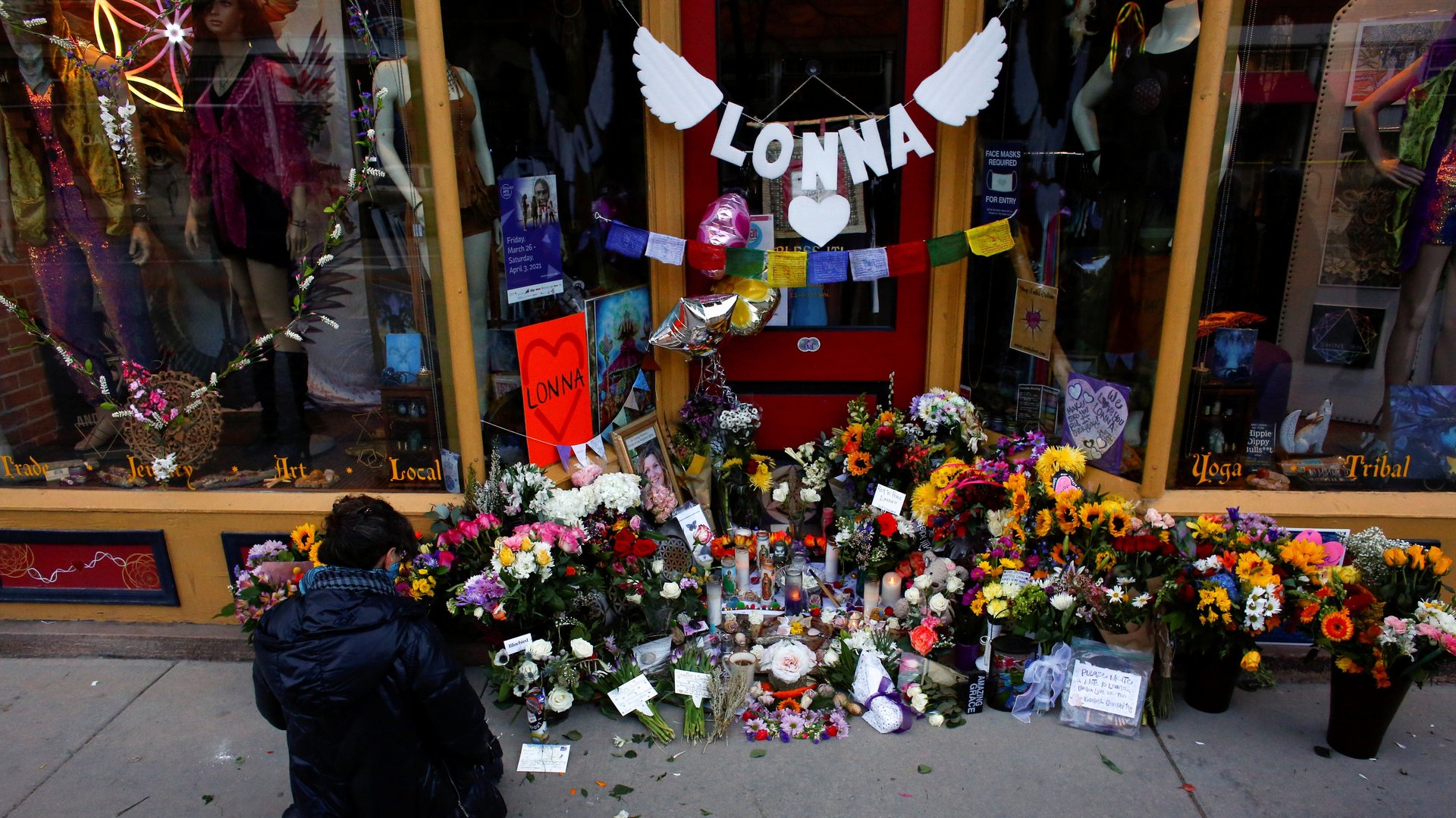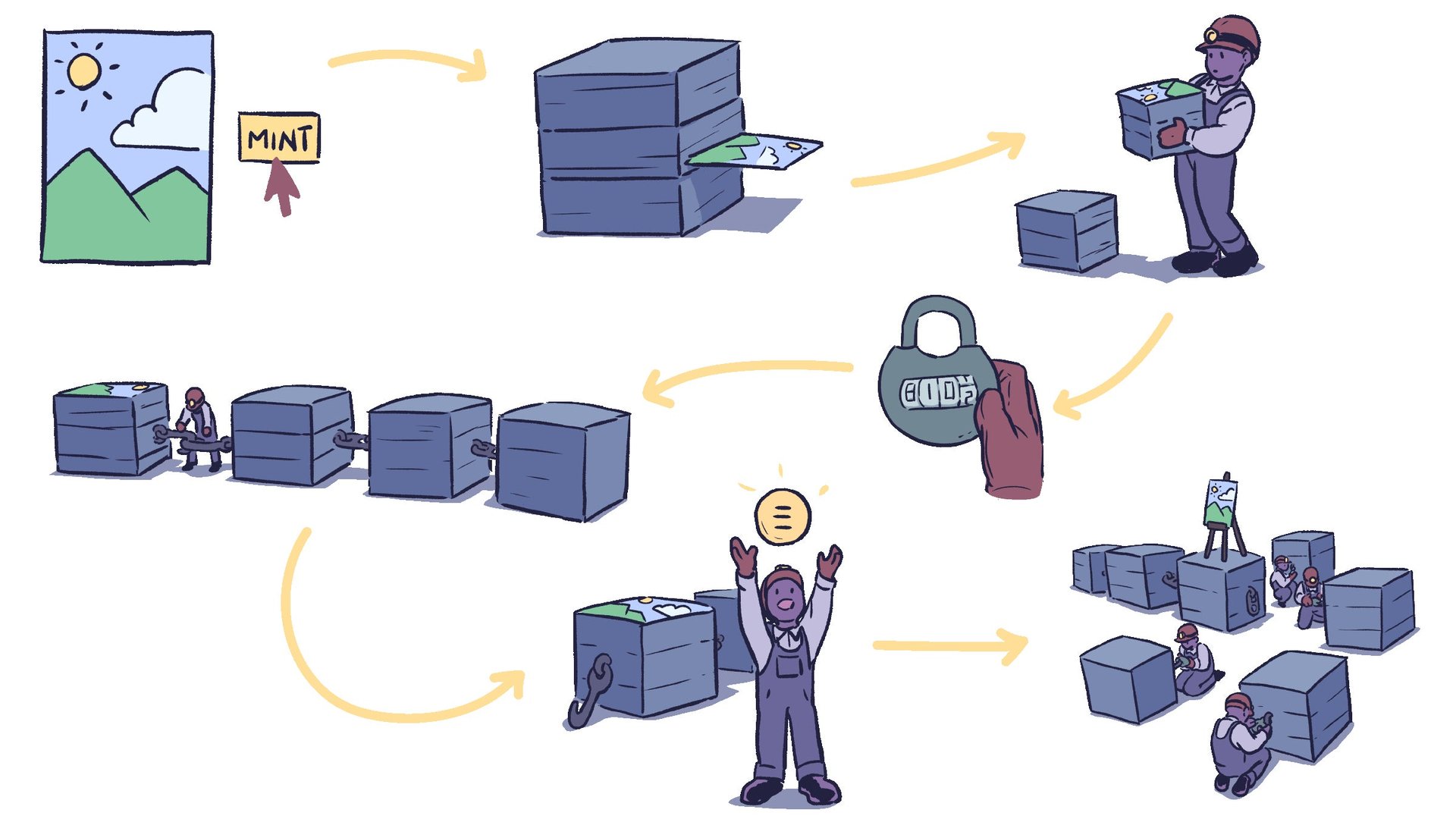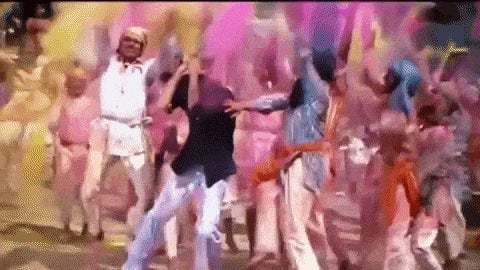The US’s other health crises, Suez Canal fiasco, NFTs’ carbon footprint
Good morning Quartz readers!


Good morning Quartz readers!
The pandemic that locked the US up for a year—causing 550,000 deaths, and the near-complete interruption of life as we knew it—was also a long pause in one of the nation’s biggest health emergencies: mass shootings.
Before March 16, when a killer targeted three Asian spas in Atlanta, killing eight, there hadn’t been a mass shooting in about a year. But it took less than a week for the second such incident to occur—on March 22, when a gunman killed 10 people in a Colorado grocery store.
It’s only fair to expect there will be more. While there may not have been any mass shootings during the pandemic, gun violence never went anywhere—it was just harder to find crowds to unleash it on. In fact, 2020 was a record year for firearm deaths, which cost over 19,200 lives—a 25% increase over the previous year, bringing the toll of gun violence to over 653,000 deaths since 2001.
Covid-19 was an exceptional public health crisis for the US in both intensity and impact. Yet, assuming the vaccination effort continues to be effective, short-lived compared to America’s other long-standing health crises—above all gun violence, opioid overdoses, and systemic racism (which causes, among other issues, worse health outcomes, increased physical danger, and shorter life spans).
Following a year that increased psychological distress, unemployment, financial uncertainty, and isolation for millions of Americans, the public health plagues that have affected the US for decades (or centuries) are bound to emerge worse than they were before. But they don’t need to be. Gun violence, in particular, has long had a known path to substantial improvement, if not an outright solution.
The White House called on Congress to push for an assault weapon ban and tougher background checks, and is reportedly considering an executive order on gun control. The time is now to impose the kind of regulations that keep gun deaths at lower levels in most other countries. The hundreds of thousands we lost to firearms are a damning reminder that, in fact, it is already far too late. —Annalisa Merelli
Five things from Quartz we especially liked

Art’s critical moment. The NFT craze is touted by some as the way the art world is inevitably headed, but must it be that way? And should it? In this illustrated explainer, Erin Davis compares the carbon footprint of creating an NFT and delivering it to a paying customer, versus shipping a print piece the old-fashioned way, and points out that we can choose whether we want this energy-sucking practice to become normalized. —Susan Howson, email editor
How to get Europeans to trust the AstraZeneca vaccine. Even as the EU struggles with a third wave of Covid-19, polls show that suspicion of AstraZeneca is on the rise. Annabelle Timsit masterfully captures the way that public health depends on respectfully addressing people’s concerns about the vaccine: “The next frontier of the pandemic for Europe will be played out not in hospitals, but in people’s minds.” —Sarah Todd, senior reporter
This week’s debacle wasn’t even the worst Suez Canal fiasco. At the outbreak of the Six-Day War against Israel in 1967, Egypt closed the vital trade route for eight years, leaving behind the Yellow Fleet, a group of 14 cargo ships that remained stuck for that entire period. The ships’ owners rotated their crews until 1975, Sarah Todd writes, and even held their own Olympics in 1968. —Hasit Shah, news editor
A spotlight on coronavirus’s origins. More than a year into the Covid-19 pandemic, we still don’t have clear answers on where the virus came from. Did it cross over from bats? Was it leaked from a lab? As Katherine Foley writes, the answer matters because it can help the world be more prepared for the next pandemic. But it will also have major geopolitical consequences. —Alexandra Ossola, deputy membership editor
Robot garbage hunters are coming to clean up space. There are 8,000 metric tons of debris whizzing through Earth’s orbit at 5 miles (8 km) per second, endangering the satellites that watch the weather, allow us to communicate, and beam internet to rural areas. Quartz’s resident spaceman Tim Fernholz offers an in-depth look at the nascent industry trying to prove it can destroy orbital junk, repair aging satellites, and offer humanity a more sustainable future in space. —Nicolás Rivero, tech reporter
One membership thing that made us 🚗
Tesla has already changed the automobile industry, and is poised to change it further. Here’s what it has going for it.
🏭 Innovative, efficient manufacturing. Tesla’s great innovation hasn’t just been in its cars—it’s been in its factories. Its latest advance involves a die cast machine that allows it to replace 70 pieces of welded metal with a single slab of cast aluminum, resulting in huge savings.
🤑 Access to capital. A stratospheric valuation means the company is essentially minting money and throwing it at anything it wants—at least, while it lasts.
💻 Systems engineering. Unlike legacy automakers, which focus on the hardware and outsource their software, Tesla took a page from Apple’s playbook: it builds its software in-house on top of custom hardware ensuring its vehicles are a single, integrated system.
🚀 The Tesla fan club. Tesla’s most durable competitive advantage may be the legions of fans who bought its cars and rallied behind its stock during the hard times, and may have formed a lifetime allegiance to the brand. Time will tell.
✦ Not every automaker is going to survive the shift to electric cars. Tesla redefined the competitive advantage. Plug in with our field guide: Tesla takes on the world. Stuck at the traffic stop because you don’t yet have a Quartz membership? Try it for a week, no charge.
We’re obsessed with Holi

An annual splash of color. The festival of Holi has long been emblematic of India’s diverse and multicultural society, a celebration that seemingly transcends religions and communities. Its aesthetic is Instagram-friendly, Bollywood-friendly, pool-party friendly, and a uniquely common social experience shared by baby boomers, millennials, and Gen Z alike. If you’re trying to recreate Holi in the West, however, you might be dangerously close to falling into a cultural appropriation trap. Either way, get ready to be covered in all of Holi’s colors with the Quartz Weekly Obsession.
Get the Weekly Obsession email sent to your inbox, for free!
Five things from elsewhere that made us smarter
Making the desert bloom has been a perennial dream for humanity. Dutch engineer Ties van der Hoeven saw it succeed in China’s Loess plateau by watching a 2012 documentary. Now, his company, the Weather Makers, is working to turn more of the world’s arid ecosystems green again starting with Egypt’s Sinai peninsula. “It is going to be a step as big as fire was for humanity,” van der Hoeven claims in a profile by Steve Rose in the Guardian. —Michael Coren, senior reporter
Follow the money. So goes the old journalism adage—and that’s exactly what Reuters’ Sarah Wu and Nichola Saminather have done in this superbly reported piece. Using financial records to paint a picture of migration, the reporters quantify the wave of Hong Kongers looking to emigrate by examining the record flows of capital entering Canada from Hong Kong, where Beijing is waging a campaign of authoritarian repression. —Mary Hui, reporter
Slowly unplugging. Sociologist Sherry Turkle has chronicled technology’s role in our identities and interactions for decades. The isolation of Covid-19 and extreme dependence on tech, however, has turned us into orcas in captivity, Corinne Purtill writes for the New Yorker, and the next observation for Turkle will be what happens as we re-integrate ourselves to having real-life interactions when those skills have become rusty. —Katherine Ellen Foley, health reporter.
The hydrodynamics that stopped the world. Why exactly is the Ever Given stuck in the bank of the Suez Canal, sending delays cascading throughout global shipping? The answer, as the Financial Times’ Brendan Greeley explains in charming detail, involves the unique physics of ships in shallow water and the financial imperative for mega freighters to grow ever-wider. —Tim Fernholz, senior reporter
Whoever knows the way. I get lost easily—in space, more than in life (or so I like to believe). But much as it is impractical, indeed often frightening, there is a magic to getting lost, to knowing each step could turn to adventure, to the thrill of finally finding your way. In his New York Times essay about walking through the world’s largest labyrinth, Cosimo Bizzarri places his riddled journey through the maze within the history and philosophy of labyrinthic pursuits, offering a meditation on the inevitability of feeling lost and the lessons it can teach us. —Annalisa Merelli, reporter
Our best wishes for a relaxing but thought-filled weekend. Please send any news, comments, space debris, and labyrinth maps to [email protected]. Get the most out of Quartz by downloading our app and becoming a member. Today’s Weekend Brief was brought to you by Liz Webber.